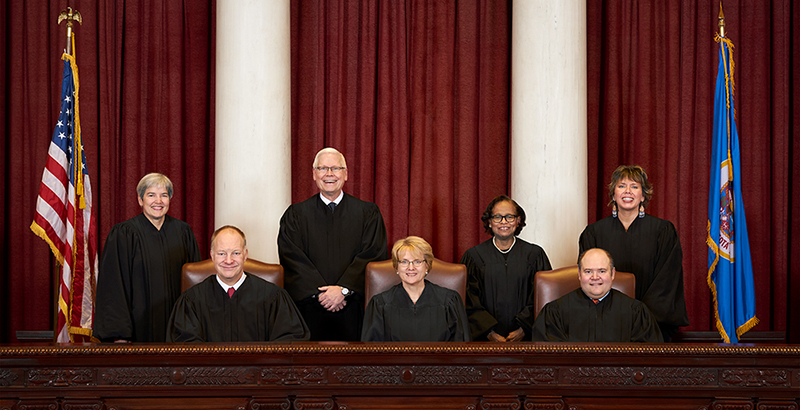Key Minnesota Desegregation Case Asks Chilling Question: Can Supreme Court Intervene to Guarantee an Adequate Public Education?

When the Minnesota Supreme Court gavels itself into session Tuesday, the audience is likely to be overflowing with lawyers who have at best mixed feelings about the meatiest case on the docket: Cruz-Guzman v. State of Minnesota, which claims that increasing segregation in Minneapolis and St. Paul schools violates the state constitution.
The arguments will address only whether the high court should allow the two-year-old case to go forward. The state attorney general’s office has argued that the suit should be dismissed on the grounds that the court has no authority to intervene to uphold a clause in the state constitution that guarantees an adequate public education for all.
It’s a narrow question with sweeping implications, so much so that even many of those who want the suit to fail fear the precedent that could be set. Concluding that a court can’t uphold the constitution, they say, would be a short-term win with catastrophic long-term implications.
One of the most vocal of those opponents is Jerry Von Korff, an attorney in St. Cloud, the small city in central Minnesota where he has served on the school board for 15 years. In recent months, Von Korff has written more than a dozen sharply critical blogs, a 75-page law review article and an impassioned letter to Gov. Mark Dayton.
“Your name is attached to a state of Minnesota brief that could severely undermine one of Minnesota’s most important constitutional rights,” Von Korff wrote to Dayton in August. “If your argument prevails in the Supreme Court, you will be inadvertently handing the opponents of a strong and vibrant public education system a powerful means to destroy our public schools.”
Lawmakers and governors, Von Korff reminded, have varying ideas about the role — and the financial needs — of public schools. Surely the outgoing Dayton, a former schoolteacher who styled himself the education governor, did not want his legacy capped by winning a legal precedent that would allow a future regime to gut education, Von Korff suggested.
Nor is the issue wholly a future abstraction. A second suit, Forslund v. State of Minnesota, which challenges teacher tenure by claiming that seniority-based layoffs are harmful to impoverished minority children — and thus violate the same part of the constitution — is on hold pending the outcome of the state’s defense in Cruz-Guzman.
The full gallery expected for Tuesday’s hearing reflects the intense level of interest in the case. Six groups have submitted “friend of the court” briefs, among them a number of constitutional law scholars who agree with Von Korff’s concern. Some believe that a segregated education is inadequate by definition. Also weighing in are attorneys in the Forslund suit.
Because the plaintiffs blame public charter schools and Minnesota’s inter-district open-enrollment law for fueling segregation, some see the case as a threat to a cadre of Twin Cities schools where poor black and brown children dramatically outperform students in traditional schools.
A number of the state’s public charter schools have asked to become a formal party to the case, should it go forward. Parents choosing schools that affirm their culture is not segregation, the school leaders say; segregation is the practice of excluding children.
The case is just the latest chapter in an ongoing debate among Minnesota educators and policymakers about how, and indeed whether, to combat school segregation and how to improve the schools where poor children are concentrated. Many of the players are intimately familiar with each other’s stances.
David C. Bloomfield is a professor of education leadership, law and policy at Brooklyn College and the CUNY Graduate Center in New York. In his view, it’s unlikely the Minnesota justices will agree that educational rights can’t be defended in court. Lawmakers and other officials may decide how to deliver an adequate education, he said, but judges must be able to uphold the constitution.
“The courts have an independent role in interpreting the constitution, whether federal or state,” he said. “The court is permitted to set the floor. The legislature can exceed that floor but can’t go below it.”
Historically, setting that floor has meant officials may decide to fund high school for all students even though courts may require schools to extend only to, say, third grade. School segregation, Bloomfield added, is a natural issue to bring before a court, although raising a state constitution’s adequacy clause is an unusual way to do so.
Decades of desegregation battles
Almost two decades elapsed between the landmark U.S. Supreme Court decision Brown v. Board of Education and a federal court order finding that Minneapolis Public Schools had “intentionally and deliberately” segregated students. But no sooner had the district begun busing children to racially balanced schools than the high court handed down a second major opinion saying that in most instances majority-white suburbs could not be forced to participate in integration programs.
As the number of families of color moving to the state ballooned and white families moved to suburbs, enforcing state integration guidelines became increasingly difficult. In 1995, the Minneapolis NAACP sued, arguing that allowing poor children of color to be concentrated in inferior schools violated the constitution’s education clause.
At the time, the case garnered attention as a novelty. Lawsuits charging that states and school districts were afoul of their constitutions’ education clauses were nothing new. But most of these suits had argued that state school funding either was inadequate to pay for a decent education or was distributed unfairly. Rarely had they been brought to challenge policies elected officials had little stomach for.
Whether the gambit would have worked is unknown. The suit was settled in 1999, when Minneapolis and eight suburban school districts agreed to allow students from poor census tracts to attend suburban schools using state-funded transportation.
Nearly a decade later, researchers — including one of the architects of the settlement — were in disagreement about whether the city kids in fact achieved more in suburban schools.
Meanwhile, major concerns had surfaced about a state rule written at the time of the legal settlement that said school districts with wildly disparate demographics could tap a pot of tax dollars to engage in “voluntary integration” activities. There was widespread agreement that the rule was ineffective and much of the money wasted.
There was little consensus, however, on what to do about it. After several bitter political debates, state lawmakers appointed a bipartisan commission to study the matter. The panel eventually concluded that racial and socioeconomic integration had major benefits in and of itself, but that Minnesota’s nation-leading academic achievement gaps needed to be addressed immediately.
Complicating things, as Minneapolis and St. Paul schools became increasingly segregated, a number of public charter schools were attracting primarily students of one race or ethnicity who were dramatically outperforming their peers in traditional district schools. Fierce debate sprung up about the schools’ legitimacy, with backers insisting that a culturally affirming environment and curriculum was part of their success.
In 2013, lawmakers passed a new Achievement and Integration law that said schools should continue to “pursue” integration, but should also take a number of steps to address the immediate needs of students in inferior schools. By 2016, two things had happened: A judge had thrown out the rules the state Department of Education had produced for fulfilling the new law, and the lawyer who filed the 1995 lawsuit had brought a new case.
The new suit, which will either be thrown out or allowed to go forward depending on the decision the justices will hand down in coming months, asks the state to find a way of integrating schools throughout the seven-county Twin Cities metro area. Whether — or how — the state can order schools to integrate is not at issue at this week’s hearing.
Nor is the petition by a cross-section of the high-performing charter schools seeking to become formal parties to the case on the docket. Led by St. Paul’s mostly East African Higher Ground Academy, the schools argue that lawmakers multiple times exempted charter schools from having to comply with a number of laws, including the integration statutes. The judge who threw out the state’s latest integration rule agreed.
Tuesday’s hearing is likely to have a much more direct effect on the teacher tenure lawsuit, filed in April 2016. In that case, the parents of children in five school districts argue that a state law (since modified) requiring most teacher layoffs to be done according to seniority resulted in the concentration of the least experienced and least effective teachers in the poorest schools.
The tenure case also positions the policies that result in the inequitable distribution of teaching talent as a violation of the state constitution’s education clause. In October 2016, a trial court judge dismissed the suit, saying it had no jurisdiction in the matter.
Noting that another set of appellate judges had upheld the dismissal of the desegregation case as a matter that courts could not get involved in, the state court of appeals in September 2017 upheld the decision in the tenure case. But because the same question is at the heart of Forslund, the state Supreme Court agreed to review the suit but placed it on hold pending a decision in the desegregation matter.
For his part, Bloomfield sees the tenure challenge as less likely to proceed because the seniority and due process issues have “so many moving parts.” In addition to the question of whether the courts would “overreach” if they struck down the law, cause and effect would be hard to prove, in his opinion.
One of the attorneys pressing the tenure lawsuit, Jesse Stewart, agreed with Von Korff that the state is advancing a dangerous argument — and one that could be much further-reaching.
“It’s an odd position for the state to take in any view, because when it’s taken to its logical conclusion, it does mean the legislature can decide whatever it wants to decide,” said Stewart.
Get stories like these delivered straight to your inbox. Sign up for The 74 Newsletter

;)
